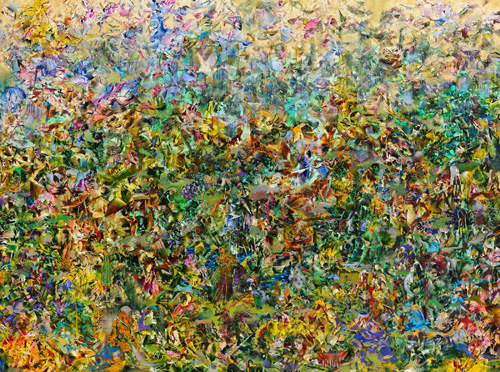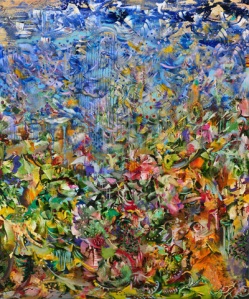Originally posted on Art-Rated on January 18, 2012. Click to view the original post.
By Jonathan Beer, Class of 2012
Since Expressionism artists have used painting to confront the interior world, wrestling to create with what German artist Willi Baumeister called “the self-engendered vision.” Like a prospector, an artist searches through layers of self-made bedrock and sediment, mining for a vein to follow. Many artists are enchanted by this parallel interior place, a zone where the fabric of reality is twisted and altered by the subconscious, intersected by memories and augmented by the imagination. It is a constantly shifting place, populated by things which have no name. There is no guidebook. A thorough investigation of the psychological is found in both abstract and representational work, from the disconcerting worlds of Yves Tanguy and Kay Sage to the imposing paintings of Milton Resnick and Mark Rothko. Somewhere between abstraction and figuration the psychological has re-emerged in the painterly fictions of Ali Banisadr.
Banisadr’s paintings have the allure of another world; their surface is inviting and mysterious, poised between the limits of understanding and the possibilities of the imagination. And they are clearly worlds; the shimmering marks coalesce as figures in landscapes, slipping between formed and formless, recalling the frenetic scenes of Breughel or Bosch. The paintings seem to transmit sound, as if each character was reciting his story at once. According to the artist, the key to opening up this other world lies in suspending his knowledge for as long as possible. In a recent visit to his studio he remarked that abstract painter Milton Resnick said “painting is about not knowing for as long as possible,” an idea that sustains his practice. We discussed how he enters this unknown:
“I always look for openings, the part of the painting that welcomes me, the part that calls me in. It could be anywhere, and I start from there. And then it becomes a dialogue. Narrative and composition become the dialogue – I put something here and then ask ‘how is it going to work with this thing over here?’ From there it just goes and goes. On a good day that’s how it is. You just start a conversation with the work and hope to disappear.”
At first glance the glimmering surface of his paintings might not reflect his subject matter, which he says, “is based on three things: the history of myself, the history of our century, and the history of art. These things aren’t going to change much.” Yet those layers of paint evoke the denseness of history and speak to the simultaneous unfolding of events we witness in our interconnected world. Through technique, Banisadr infuses these layers with poetry that communicates far beyond his ideas, allowing the audience to find their own fiction in the picture.
His best works push beyond simple aesthetic delight, moving into a zone where the imagery becomes flexible in its meaning, giving the painting an ability to say many things to more people. “I don’t make things that have names. I don’t make identifiable things – like here’s a tree or a rock or a car, I just don’t make things that way. The painting doesn’t communicate to me that way, because its paint. As paint, it’s telling me different things and those things are unnamed things. When you have a dream, there’s visual stuff going on in your subconscious you can’t really get a hold of – you can’t weigh it down and say what it is; you can’t.”
Similar to dreams or hallucinations, threads of subconscious stories that emerge in one painting are often found in others. “While one piece is ending or even mid-way through, I start to think about what I want the next piece to be like. As one piece becomes something and finishes, I find the things that I’ve learned from that painting that I want to apply to the next painting.” When viewed together his paintings become epic sagas – color and form spill from each canvas, innumerable stories running together, endlessly separating and reforming.
Today’s media driven culture issues an endless stream of shallow imagery, cementing a trend of instant visual gratification. Painting maintains an upward trajectory through the detritus, asking for focus and contemplation from its audience. Ali Banisadr’s pictures declare that painting is very much alive, and proves that there are still certain things only paint can do. His work reinforces the endurance of the painted image, each picture announcing that uniqueness and imagination still fuel the human mind. As long as artists remain curious, art will always be a perpetual act of opening up. We eagerly await the new worlds that will emerge in Banisadr’s work.
Ali Banisadr is represented by Galerie Thaddaeus Ropac in Europe.
http://www.ali-banisadr.com/
Quotes are taken from an interview with Ali Banisadr, Jon Beer and Lily Koto Olive at Ali Banisadr’s studio on December 10th, 2011.
By Jonathan Beer, Class of 2012
 |
| Ali Banisadr in the studio. |
Banisadr’s paintings have the allure of another world; their surface is inviting and mysterious, poised between the limits of understanding and the possibilities of the imagination. And they are clearly worlds; the shimmering marks coalesce as figures in landscapes, slipping between formed and formless, recalling the frenetic scenes of Breughel or Bosch. The paintings seem to transmit sound, as if each character was reciting his story at once. According to the artist, the key to opening up this other world lies in suspending his knowledge for as long as possible. In a recent visit to his studio he remarked that abstract painter Milton Resnick said “painting is about not knowing for as long as possible,” an idea that sustains his practice. We discussed how he enters this unknown:
“I always look for openings, the part of the painting that welcomes me, the part that calls me in. It could be anywhere, and I start from there. And then it becomes a dialogue. Narrative and composition become the dialogue – I put something here and then ask ‘how is it going to work with this thing over here?’ From there it just goes and goes. On a good day that’s how it is. You just start a conversation with the work and hope to disappear.”
 |
| Selection. Oil on Linen, 66 x 88 inches. 2011. (Courtesy of Gallerie Thaddaeus Ropac ©) |
His best works push beyond simple aesthetic delight, moving into a zone where the imagery becomes flexible in its meaning, giving the painting an ability to say many things to more people. “I don’t make things that have names. I don’t make identifiable things – like here’s a tree or a rock or a car, I just don’t make things that way. The painting doesn’t communicate to me that way, because its paint. As paint, it’s telling me different things and those things are unnamed things. When you have a dream, there’s visual stuff going on in your subconscious you can’t really get a hold of – you can’t weigh it down and say what it is; you can’t.”
Similar to dreams or hallucinations, threads of subconscious stories that emerge in one painting are often found in others. “While one piece is ending or even mid-way through, I start to think about what I want the next piece to be like. As one piece becomes something and finishes, I find the things that I’ve learned from that painting that I want to apply to the next painting.” When viewed together his paintings become epic sagas – color and form spill from each canvas, innumerable stories running together, endlessly separating and reforming.
 |
| Rock the Casbah (2). Oil on Linen, 36x30 inches. 2011. (Courtesy of Gallerie Thaddaeus Ropac ©) |
Ali Banisadr is represented by Galerie Thaddaeus Ropac in Europe.
http://www.ali-banisadr.com/
Quotes are taken from an interview with Ali Banisadr, Jon Beer and Lily Koto Olive at Ali Banisadr’s studio on December 10th, 2011.

it is very a nice art. .thanks a lot for showing it to me. .. great post..
ReplyDeletevapor recovery unit